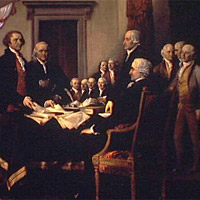 |

利文斯敦並沒有在獨立宣言上簽名,簽署時他人在紐約。

|
 |
|
 |
政治家羅伯‧利文斯敦出生,1746年11月27日
出生於紐約富裕且具影響力的家庭,利文斯敦在金恩學院─現在稱為哥倫比亞大學就讀,在那裡遇見了他追隨的律師,約翰傑伊,傑伊後來被任命為美國最高法院的
第一位首席大法官。直到英國政府任命利文斯敦擔任法律職務前,兩人成立法律事務中心實踐律法。不過利文斯敦很快就丟官,因為英國當局看到他對美洲殖民地獨立的聲援。利文斯敦在1776年6月,實踐自己的信念,和湯瑪斯傑弗遜、班哲明法蘭克林、約翰亞當斯、羅傑雪曼等人共同起草獨立宣言,在1776年7月4日獲得十三處殖民地的認同。但他的名字並沒有出現在文獻上,因為當官方簽名在1776年8月2日開始時,他的人回到了紐約。利文斯敦在馬鈴薯和蒸汽的發明上分別做了些什麼呢?
Born into a wealthy and influential New York family, Livingston studied at King's College--today known as Columbia University--where he met fellow lawyer John Jay, who would later become the first chief justice of the U.S. Supreme Court. They set up a legal practice together, until the British appointed Livingston to a New York City judicial post. He quickly lost his post, however, when the British learned of his support for independence for the American Colonies. Livingston, acting upon his beliefs in June 1776, joined Thomas Jefferson, Benjamin Franklin, John Adams, and Roger Sherman to draft the Declaration of Independence, adopted by the 13 colonies on July 4, 1776. His name did not appear on the document, though, because he was back in New York when the official signing took place on August 2, 1776. What did Livingston have to do with potatoes and steam?

 2/3 頁
2/3 頁

|





